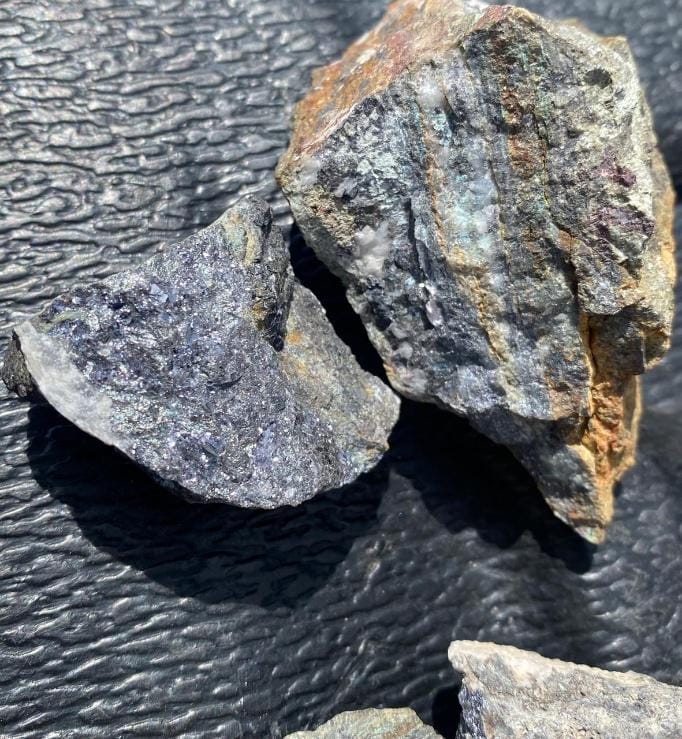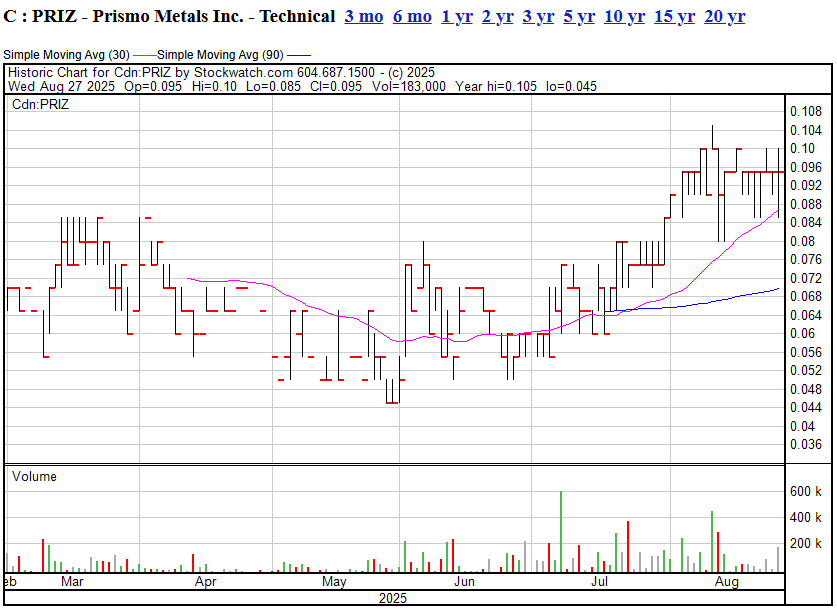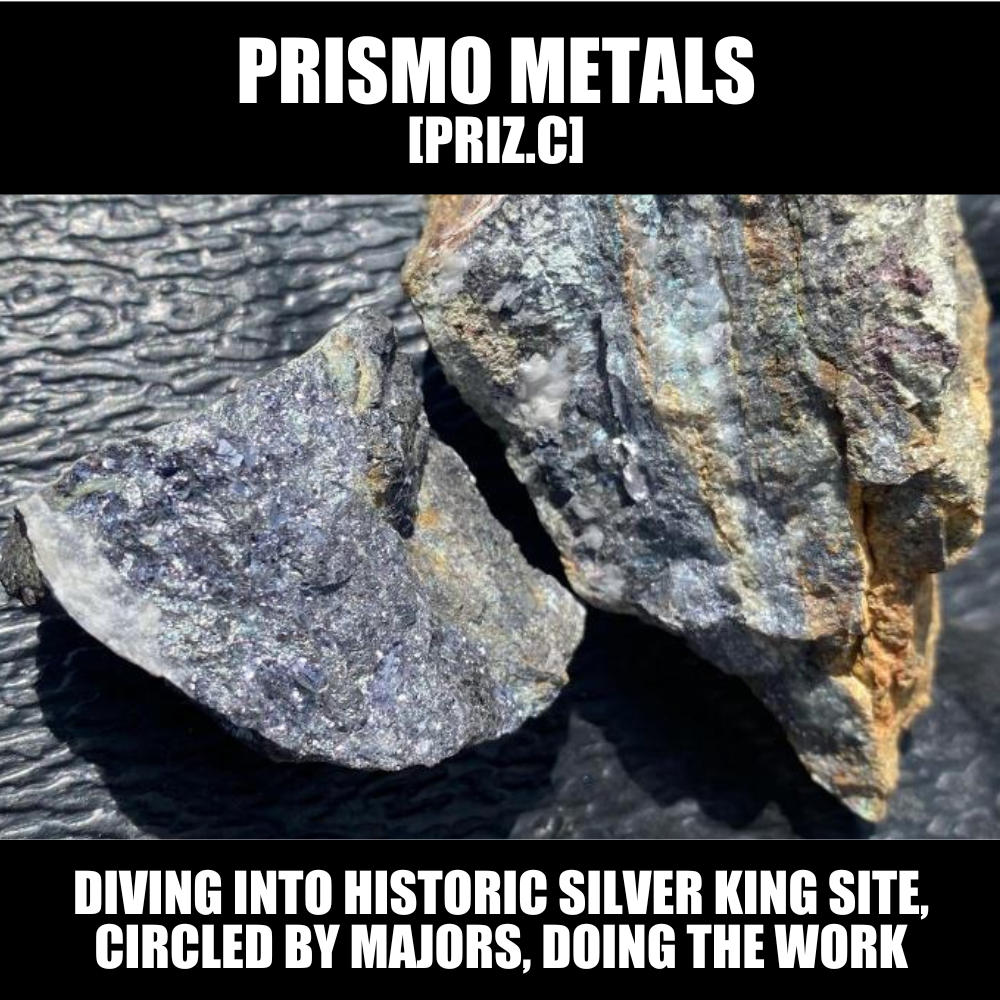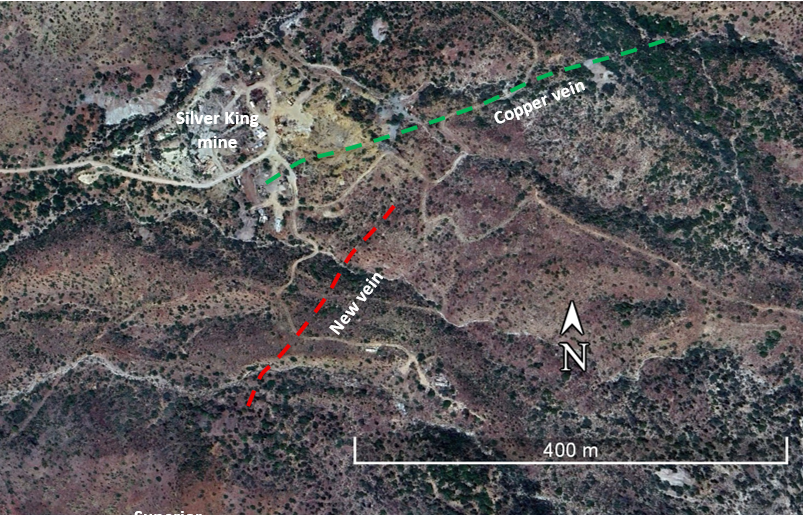 Disclaimer: This article has been paid for by Prismo Metals. See disclosures at the bottom of the page.
Disclaimer: This article has been paid for by Prismo Metals. See disclosures at the bottom of the page.
Prismo Metals (PRIZ.C) has been combing the old workings of the Silver King project in Arizona with maps, samples, and a portable XRF—the adult version of a metal detector—and the work done has already turned up two new veins that look a lot like the historic ore that made that project famous.
That’s not hype; that’s fieldwork doing its job. Samples are at the lab, the geometry lines up toward the glory hole, and the plan is to keep moving in sequence—map, model, permit, drill.
Here’s the plain-English version. That portable XRF isn’t the final word, but it’s a quick way to see if you’re sniffing in the right direction. Prismo’s XRF readings on these newly recognized veins lit up for lead, silver, copper, and zinc. That lines up with what Silver King has coughed up for nearly 150 years. Samples are already off to the lab. When those results come back, we’ll know if this is “nice rock” or “call the drillers.”
The new finds aren’t random. One vein sits in a large old mine dump roughly 300 meters south of the Silver King shaft, and more veins and pits string along another 300 meters toward the famous glory hole. In this business, geometry is gold (or silver, as the case may be). When features line up along strike and look like the main show, you pay attention.
There are little clues everywhere that people pulled serious metal here and, due to a lack of high tech at the time, didn’t chase every last ounce. Scattered around are those conical slag pieces—what you get after smelting sulfide ore back in the day—some with the tip removed where the concentrated metals would have been. Above an old smelting spot sits a stockpile of vein material, like someone pressed pause on a job and forgot to hit play again. Crack into a collapsed portal and you’ll see quartz veinlets with sphalerite, galena, and tetrahedrite. In non-geologist language, that’s a decent shopping list for silver-lead-zinc systems, with copper often riding shotgun.
THE HISTORY
Context matters, and Silver King has context. Discovered in 1875, it produced close to six million ounces of silver before 1930, with grades that still make modern miners blink. Later, in the 1990s, a small campaign pulled selected samples at eye-watering numbers—useful as a hint, but not yet as a mine plan.
But the core truth remains: this system knows how to make high-grade silver. Geologically, Silver King is a steep, west-dipping stockwork and breccia pipe mined on eight levels down to about 300 meters. Reports suggest parts of the upper body weren’t fully mined because of mineralogy and complexity, which sounds a lot like “unfinished business” if you can figure out the controls and drill it right.
Then there’s the neighborhood. Silver King sits about 3 kilometers from the Resolution Copper project’s main shaft, and not far from the historic Magma mine. You don’t need a treasure map; the whole district is the map. The host rocks are the same sequence that holds Resolution’s giant deposit, but here they’re at surface rather than buried under a volcanic blanket. That’s a practical advantage. Seeing the rocks is cheaper than guessing at them.
The Prismo team under Dr. Craig Gibson has been at it since early August: district recon, geochem, alteration mapping—the blocking and tackling you need before you spend the big dollars. They’ve submitted a plan of operations to the Forest Service and want to complete the current program in September, then move to a preliminary drill program once the permit is in hand. They also expect to access the historic 114 level soon. If they do, that should tighten up their model and possibly guide the first holes.
THE DETAIL
“During reconnaissance work, we have been working on understanding the controls of mineralization at the Silver King mine,” stated Dr. Craig Gibson, Chief Exploration Officer of the Company. “Two previously undescribed veins were discovered (Figure 1.), including one at a large mine dump about 300 meters south of the Silver King mine shaft. We believe that this may have been a significant silver producer. Several veins and prospect pits occur 300 meters along strike to the NE to a point near the Silver King glory hole. This is the first time we have observed mineralization similar to the Silver King deposit outside of the historic mine and it provides a new exploration target.”
What’s that look like up close?

LET’S CUT TO THE CHASE
Let me boil this down to the three things Prismo has going for it, and one thing they should sharpen.
Three things going for them:
-
Location you can sell on a napkin. Being ringed by Resolution’s claim block isn’t just an interesting fact; it’s strategic leverage. When you’re exploring where world-class deposits already live, your odds of meaningful geology go up, and your future options multiply. Infrastructure, data, interest—these are not small things.
-
A system with a résumé. Silver King isn’t speculative science fiction. It’s a past producer with real tonnage and real grades. The newly identified veins have the same mineral character as the historic ore, and the site is littered with physical evidence of past extraction. Add the possibility of accessory metals like antimony (through minerals such as freibergite), and you’ve got potential by-product credits that can move economics in a good direction.
-
Execution that’s paced, not panicked. They’re doing the work in the right order: map, sample, model, permit, drill. Samples are at the lab; the plan of operations is in; they’re trying to open the 114 level to see more rock before deciding exactly where to poke holes. None of that is flashy. All of it is how you avoid Swiss-cheese drilling and wasted cash.
One thing to work on:
Turn the hints into headlines. XRF hits, historical grades, and vein geometry are good hints, but this market pays for verified data. The first lab assays need to land cleanly, with context—where the samples came from, how they tie to the mapped veins, what the host rocks and alteration say. Then, the opening drill program needs to be disciplined and aimed at questions: continuity, width, grade distribution, and the geometry that connects these new veins to the main pipe. If permitting is the gate, make that the top operational priority. The narrative changes when you move from “this looks right” to “this is right,” backed by consistent numbers and a structural model you can draw on one page.
HOW EXCITED SHOULD YOU BE?
Call it a solid four out of five on the “things are getting interesting” scale. Not hype, not hand-waving—just a straightforward case of a good address, a proven system, and early fieldwork that lines up with the history. There’s real substance here, and also real work ahead. That’s how it should be.
Picture the next few steps. Assays arrive and either confirm the XRF pattern or tell them to recalibrate. The 114 level opens, giving line-of-sight to vein orientations, widths, and contacts. The drill permit shows up, and they lay out a handful of smart holes along the vein traces toward the glory hole, plus a shot or two at the dump-hosted vein south of the shaft. Early holes don’t need to be barnburners; they need to be informative. With each intercept, the model tightens, and the targeting improves. That’s the progression you want in a district like this.
One last thing I appreciate: the tone from the top isn’t breathless. The president talks about the “prevalence and scale” of mines in the district and calls acquiring a past producer with little modern work a rare opportunity. That’s accurate. Past producers often hide new stories when viewed with modern tools and a better handle on structure and mineralogy. But you still have to earn it. The ground doesn’t care about press releases.
BOTTOM LINE
Prismo Metals has put solid building blocks in place at Silver King—new veins that match the right recipe, a historically loud system in a very good postal code, and a team moving in sequence rather than sprinting in circles. Now comes the important part: get the lab numbers, secure the permit, put steel in the ground, and let the geology answer the only question that matters—how much, how consistent, and how fast can you prove it? If they keep the current pace and stay disciplined, this could graduate from “promising update” to “compelling program” in short order. That’s not a victory lap. That’s just good, steady exploration—exactly what you want to see.

— Chris Parry



Leave a Reply